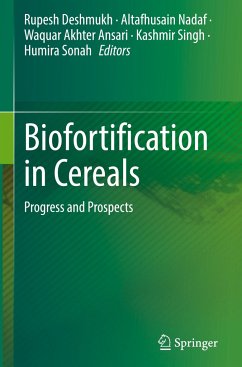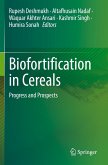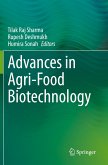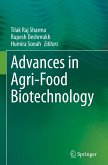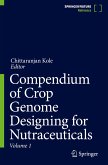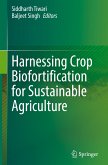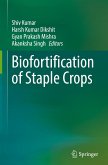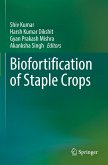Biofortification in Cereals
Progress and Prospects
Herausgegeben:Deshmukh, Rupesh; Nadaf, Altafhusain; Ansari, Waquar Akhter; Singh, Kashmir; Sonah, Humira
Biofortification in Cereals
Progress and Prospects
Herausgegeben:Deshmukh, Rupesh; Nadaf, Altafhusain; Ansari, Waquar Akhter; Singh, Kashmir; Sonah, Humira
- Gebundenes Buch
- Merkliste
- Auf die Merkliste
- Bewerten Bewerten
- Teilen
- Produkt teilen
- Produkterinnerung
- Produkterinnerung
The book addresses recent advances in biofortification using different approaches like foliar fertilizer, plant breeding, and genetic engineering as well as its utilization for improvement of nutritional quality of cereals. The content compiled is contributed by the renowned scientists actively working in the area of the cereal biofortification. This is an authentic, reliable, and exhaustive compilation bringing together the technological advancements, fundamental principles, and applicability of scientific innovations in biofortification. It also discusses policies and regulations for the…mehr
Andere Kunden interessierten sich auch für
![Biofortification in Cereals Biofortification in Cereals]() Biofortification in Cereals105,99 €
Biofortification in Cereals105,99 €![Advances in Agri-Food Biotechnology Advances in Agri-Food Biotechnology]() Advances in Agri-Food Biotechnology177,99 €
Advances in Agri-Food Biotechnology177,99 €![Advances in Agri-Food Biotechnology Advances in Agri-Food Biotechnology]() Advances in Agri-Food Biotechnology177,99 €
Advances in Agri-Food Biotechnology177,99 €![Compendium of Crop Genome Designing for Nutraceuticals Compendium of Crop Genome Designing for Nutraceuticals]() Compendium of Crop Genome Designing for Nutraceuticals664,99 €
Compendium of Crop Genome Designing for Nutraceuticals664,99 €![Harnessing Crop Biofortification for Sustainable Agriculture Harnessing Crop Biofortification for Sustainable Agriculture]() Harnessing Crop Biofortification for Sustainable Agriculture161,99 €
Harnessing Crop Biofortification for Sustainable Agriculture161,99 €![Biofortification of Staple Crops Biofortification of Staple Crops]() Biofortification of Staple Crops121,99 €
Biofortification of Staple Crops121,99 €![Biofortification of Staple Crops Biofortification of Staple Crops]() Biofortification of Staple Crops121,99 €
Biofortification of Staple Crops121,99 €-
-
-
The book addresses recent advances in biofortification using different approaches like foliar fertilizer, plant breeding, and genetic engineering as well as its utilization for improvement of nutritional quality of cereals. The content compiled is contributed by the renowned scientists actively working in the area of the cereal biofortification. This is an authentic, reliable, and exhaustive compilation bringing together the technological advancements, fundamental principles, and applicability of scientific innovations in biofortification. It also discusses policies and regulations for the implication of various strategies. It is useful reading material for researchers and students in the field.
Produktdetails
- Produktdetails
- Verlag: Springer / Springer Nature Singapore / Springer, Berlin
- Artikelnr. des Verlages: 978-981-19-4307-2
- 1st edition 2023
- Seitenzahl: 400
- Erscheinungstermin: 15. Februar 2023
- Englisch
- Abmessung: 241mm x 160mm x 26mm
- Gewicht: 836g
- ISBN-13: 9789811943072
- ISBN-10: 9811943079
- Artikelnr.: 64092663
- Herstellerkennzeichnung Die Herstellerinformationen sind derzeit nicht verfügbar.
- Verlag: Springer / Springer Nature Singapore / Springer, Berlin
- Artikelnr. des Verlages: 978-981-19-4307-2
- 1st edition 2023
- Seitenzahl: 400
- Erscheinungstermin: 15. Februar 2023
- Englisch
- Abmessung: 241mm x 160mm x 26mm
- Gewicht: 836g
- ISBN-13: 9789811943072
- ISBN-10: 9811943079
- Artikelnr.: 64092663
- Herstellerkennzeichnung Die Herstellerinformationen sind derzeit nicht verfügbar.
Dr. Rupesh Deshmukh is working as Ramalingaswami Fellow, at National Agri-food Biotechnology Institute, Mohali, Punjab, India. Earlier he was visiting professor at Laval University in Quebec, Canada. He obtained his Ph.D. degree in Agriculture Biotechnology at SRTMU, Nanded, India. He went to Quebec, Canada for his postdoc. He did another postdoc at Missouri University, USA. His interest spans diverse fields in plant science covering computational biology, gene identification through approaches like QTL mapping and GWAS, and elucidation of the molecular mechanism through the integration of omics approaches. His research group is exploring genomics and genome editing approaches to improve the nutritional quality of rice. He has published five books and more than a hundred articles in reputed journals. He is a member of many academic societies and served as an editorial board member and guest editor. Dr. Altafhusain Nadaf is working as a Professor at the Department of Botany, Savitribai Phule Pune University, Pune; in the area of biochemistry and molecular genetics of aromatic rice for the past 18 years. He was awarded Erasmus Mundus Action 2 India4EU II scholarship to visit the University of Bologna, Italy as a visiting professor and DST-BOYSCAST Fellowship to work as a Visiting Fellow at the Centre for Plant Conservation Genetics, Southern Cross University, Lismore, Australia for one year. He has in his credit four books and more than 50 research papers published in peer-reviewed national and international journals of repute. His research interests are biochemistry and molecular genetics of rice aroma volatiles. He has characterized scented rice varieties of India and other plant species containing rice aroma volatiles following the HS-SPME-GC-MS/FID approach. Moreover, the aroma enhancement and induction of aroma character have been achieved in his laboratory through transgenic approaches. Dr. Waquar Akhter Ansari is workingas DS Kothari Post Doctoral Fellow, at the Department of Botany, Savitribai Phule Pune University, Pune, Maharashtra, India. Earlier he worked as Research Associates in the different national projects at ICAR-Indian Institute of Vegetable Research and ICAR-National Bureau of Agriculturally Important Microorganism. He obtained his Ph.D. degree from the department of botany Banaras Hindu University, Varanasi, Uttar Pradesh, India, in the subject of biotechnology. He has more than 10 years of research experience in the field of plant biotechnology. He has published more than 20 papers in reputed journals. He has received several awards for best oral and poster presentations at international and national conferences. Dr. Humira Sonah is currently working as Ramalingaswami Fellow at National Agri-Food Biotechnology Institute (NABI), Mohali, India. Before joining NABI, Dr. Sonah was Visiting Professor at University Laval, Canada. She obtained her Ph.D. degree in Biotechnologyat Banasthali University, India. Dr. Sonah went to Quebec, Canada for her postdoc where she worked on the development of cost-efficient genotyping by sequencing (GBS) technology in plants. She and her research team developed GBS protocols for different crop species and subsequently used the SNP genotyping for genome-wide association studies (GWAS). She has developed genome-wide molecular markers for different crops. Her interest covers different fields in plant science including whole genome sequencing, computational biology, QTL mapping, GWAS, genomic selection, and integration of omics approaches. Dr. Sonah has published more than sixty articles in reputed journals. She is serving as a member of many academic societies and as a guest editor in reputed journals. Dr. Kashmir Singh is presently working as a Professor and Head of the Department at the Department of Biotechnology, Panjab University, India. He carried out his Ph.D. studies in India (CSIR-IHBT), where he gotspecialized in biotechnology and plant genomics. He did his Postdoctoral Research at Adam Mickiewicz University, Poland, Missouri State University, USA, and McGill University, Canada. His research is focused on the exploration of genomics for a better understanding of stress tolerance mechanisms in plants. He has published over eighty articles in reputed journals.
Chapter 1. Agronomical approaches for biofortification of cereal crops.- Chapter 2. Molecular approaches for biofortification of cereal crops.- Chapter 3. Molecular Approaches for Biofortification of Cereal crops.- Chapter 4. Genome editing approaches for biofortification of cereal crops.- Chapter 5. Metabolomics approaches to study nutritional aspects in cereal crops.- Chapter 6. Biofortification of Rice (Oryza sativa L.).- Chapter 7. Biofortification of wheat using current resources and future challenges.- Chapter 8. Biofortification of maize (Zea mays).- Chapter 9. Biofortification of barley for nutritional security.- Chapter 10. Biofortification of sorghum (Sorghum bicolor).- Chapter 11. Biofortification of oats (Avena sativa).- Chapter 12. Nutrigenomics in Cereals.- Chapter 13. Genetically modified cereal crops regulation policies.- Chapter 14. Nanotechnological approaches for biofortification concept and concern in cereal crops.
Chapter 1. Agronomical approaches for biofortification of cereal crops.- Chapter 2. Molecular approaches for biofortification of cereal crops.- Chapter 3. Molecular Approaches for Biofortification of Cereal crops.- Chapter 4. Genome editing approaches for biofortification of cereal crops.- Chapter 5. Metabolomics approaches to study nutritional aspects in cereal crops.- Chapter 6. Biofortification of Rice (Oryza sativa L.).- Chapter 7. Biofortification of wheat using current resources and future challenges.- Chapter 8. Biofortification of maize (Zea mays).- Chapter 9. Biofortification of barley for nutritional security.- Chapter 10. Biofortification of sorghum (Sorghum bicolor).- Chapter 11. Biofortification of oats (Avena sativa).- Chapter 12. Nutrigenomics in Cereals.- Chapter 13. Genetically modified cereal crops regulation policies.- Chapter 14. Nanotechnological approaches for biofortification concept and concern in cereal crops.

